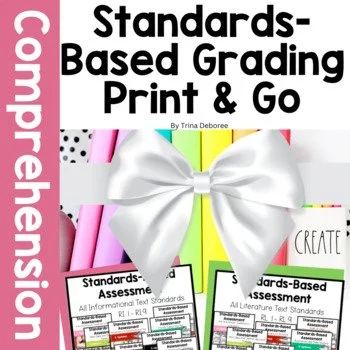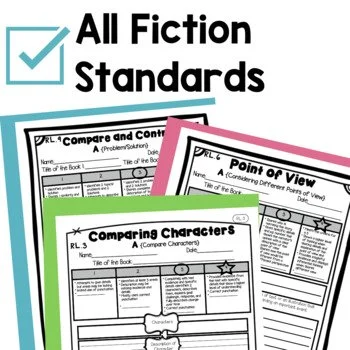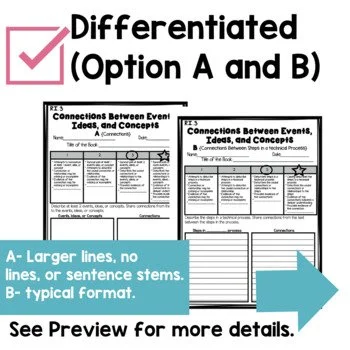2nd Grade Standards Based Grading: Reading Comprehension Assessment BUNDLE
How do you assess a second grader’s reading comprehension for report cards? This question can be particularly difficult if you are required to follow a standards-based grading report card. Second Grade ELA Reading Comprehension Year-Long Curriculum Bundle provides a quick reading comprehension assessment for each of the Common Core standards. This print version makes it easy to make two piles- got-it and needs more work making small group creation a breeze.
Standards-Based grading has never been easier for standards-based report cards with this assessment bundle which includes standards-based grading rubrics on each graphic organizer. This differentiated assessment bundle for second grade is a differentiated approach to assessment. This product was created to help teachers assess all ELA reading standards. This pack addresses all informational text standards {RI.1-RI.9} and literature standards {RL.1-RL.9}. My hope is that you will have a variety of ways to see what your students know. There are two options for each assessment (with 5-10 different approaches to assessing all standards).
★ The open-ended nature of these graphic organizer assessments allows me the opportunity to see how a child is processing information and thinking independently.
★ This set contains the Standards-Based Assessment for ALL Literature and Informational Text Standards.
This pack contains:
* Two options for each assessment- one with more support
* Rubric to ensure that your students are fully aware of the criteria before completing the page
* Blanks are left on the rubric so that you can include your students with setting expectations for their work
* General Essential Questions for the Standard Assessed
* General Standards-Based Assessment Rubric
Assessments for RL.1(with option A and B for each):
*Formulating Questions
* General Question (Blank- for teachers own question)
* Questions about character
* Questions about problem
* Questions about setting
* Questions about predictions
Assessments for RL.2(with option A and B for each):
* Retelling/Recounting
* Retelling/Main Message
* Story Analysis and Summary
* Character Analysis and Story Summary
* Character Actions and Story Summary
* General Rubric
Assessments for RL.3(with option A and B for each):
* Characters
* Characters, Events, and Responses
* Characters, Events, and changes
* Comparing Characters
* Comparing Characters with Venn diagram (alternative option)
* Comparing Setting
* Comparing Setting with Venn diagram (alternative option)
* Comparing Events
* Comparing Events with Venn diagram (alternative option)
* Comparing Characters and more
* General Rubric
Assessments for RL.4(with option A and B for each):
* Vocabulary
* Vocabulary with Picture Response
* Vocabulary with Synonym
* Vocabulary with Synonym and Antonym
* Vocabulary with Semantic Web
* Vocabulary with Semantic Web/Illustrations
* Vocabulary with Word Meaning
* General Rubric
Assessments for RL.5(with option A and B for each):
* Comparing Stories and Informational Text
* Semantic Features of Genres
* Structure- Beginnings
* Structure- Endings
* Analyzing Structure
* Comparing Endings
* Comparing Beginnings
* Comparing Structures with Venn Diagrams
* General Rubric
Assessments for RL.6(with option A and B for each):
* Identifying Point of View
* Point of View with the Narrator
* Point of View- Comparing to your own
* Point of View-Comparison
* Point of View-Comparing more detailed
* Point of View-Comparing with different text
* General Rubric
Assessments for RL.6(with option A and B for each):
* Illustrations and Character/Setting
* Illustrations and Responding to Events
* Illustrations and Problem/Solution
* Illustrations and Mood
* Illustrations and Artist Techniques
* Illustrations to Retell
* General Rubric
Assessments for RL.9 (with option A and B for each):
* Comparing Text
* Comparing Text/Venn Diagram
* Comparing Characters
* Comparing Characters/Venn Diagram
* Comparing Setting
* Comparing Setting/Venn Diagram
* Comparing Events
* Comparing Events/Venn Diagram
* Comparing Topics/Themes
* Comparing Topics/Themes/Venn Diagram
* Comparing Problem/Solution
* Comparing Problem/Solution/Venn Diagram
* Comparing Character Response to Events
* Comparing Endings
* General Rubric
Assessments for RI.1(with option A and B for each):
*Formulating Questions
* General Question (Blank- for teachers own question)
* Wonder and Learned
* What, Why, When, Where, How, and Why
* Sharing Information
* Questions about Predictions/Conclusions
* Questions about Purpose with Evidence
Assessments for RI.2 Main Idea/Supporting Details(with option A and B for each):
* Main Idea
* Main Idea and Its Parts
* Summarizing the Main Idea
* Main Idea and Its Parts
* Summarizing the Main Idea
* Main Idea and Supporting Details
* Main Idea in Pictures
Assessments for RI.3 Cause and Effects and the Connections within Events, Ideas, and Procedures (with option A and B for each):
* Connections
* Connections between steps in a procedure
* Cause and Effect Chain
* Cause and Effect Web
* Important Events, Ideas, and Procedures
Assessments for RI.4(with option A and B for each):
* Vocabulary
* Vocabulary with Picture Response
* Vocabulary with Synonym
* Vocabulary with Semantic Web
* Vocabulary with Semantic Web/Illustrations
* Vocabulary with Word Meaning
Assessments for RI.5 Text Features (with option A and B for each):
* Text Features- What, Purpose, and How They Help
* Organizational Features (table of contents, headings and or subheadings, index)
* Organizational Features (diagrams, charts and graphs, and maps)
* Informational Features (illustrations, captions, and labels)
* Informational Features (Bold, italics, and or colored print, and glossary)
* Electronic Features (electronic menu, electronic sidebar, and icons)
* Electronic Features (search terms or key words and hyperlinks)
Assessments for RI.6 Point of View/Author's Purpose (with option A and B for each):
* Author's Purpose/Evidence
* Author's Feelings
* Author/Illustrator
* Author's Point of View/Reader's Point of View
* Author's Point of View/Reader's Point of View Venn Diagram
* Author's Point of View/Author's Point of View
Assessments for RI.7 Visuals/Images Supporting Text (with option A and B for each):
* Image Information
* Image and Key Details
* Images and Meaning
* Creating Images/Meaning
Assessments for RI.8 Making Connections in Text (with option A and B for each):
* Author's Point with Evidence Support
* Main Idea and Evidence
* Main Idea and Evidence {T-chart}
* Main Idea and Evidence {Venn Diagram}
* Main Idea and Evidence {Cause and Effect}
* Author's Point of View/Author's Point of View
Assessments for RI.9 Compare and Contrast Same Topic Texts (with option A and B for each):
* Gather Information From Two Sources
* Compare and Contrast Two Sources
* Venn Diagram comparison
* Compare and Contrast Images
* Compare and Contrast Descriptions
* Venn Diagram Descriptions
* Compare and Contrast Procedures
* Venn on Procedures
* Integrating Sources





